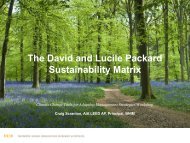State WAP Revised 8.29.06.indd - Teaming With Wildlife
State WAP Revised 8.29.06.indd - Teaming With Wildlife
State WAP Revised 8.29.06.indd - Teaming With Wildlife
Create successful ePaper yourself
Turn your PDF publications into a flip-book with our unique Google optimized e-Paper software.
Key Habitats<br />
<strong>Wildlife</strong><br />
(examples)<br />
Issue (examples)<br />
Action (examples)<br />
Appalachian<br />
Oak-Pine Forest<br />
13% protected<br />
with 7.5%<br />
permanently<br />
protected<br />
in public<br />
and private<br />
ownership.<br />
Eastern red<br />
bat, Timber<br />
rattlesnake, Whippoor-will,<br />
Bobcat<br />
Development or<br />
conversion of habitat<br />
into home lots,<br />
roads, businesses,<br />
etc.; resulting<br />
fragmentation<br />
degrades quality of<br />
remaining habitat.<br />
• Develop and implement Regional Conservation Plans.<br />
• Advise Conservation Commissions, - Open Space<br />
Committees and Planning Boards.<br />
• Improve interagency coordination for environmental<br />
reviews.<br />
Pine Barrens<br />
19% protected<br />
in public/<br />
private<br />
partnerships<br />
and ownership.<br />
Karner blue<br />
butterfly, Pine<br />
pinion moth, New<br />
England cottontail<br />
Fire suppression (this<br />
habitat is maintained<br />
by fire and other<br />
natural disturbances);<br />
lack of active<br />
management results in<br />
habitat degradation.<br />
• Develop protocols for limiting activity in sensitive<br />
habitats.<br />
• Prioritize and refine strategies to conserve wildlife.<br />
• Revise endangered species list.<br />
Non-tidal<br />
Coastal<br />
Watershed<br />
11% protected<br />
in public<br />
and private<br />
ownership.<br />
Brook floater,<br />
Atlantic salmon,<br />
Shortnose<br />
sturgeon, Redfin<br />
pickerel, Banded<br />
sunfish, Bald<br />
eagle<br />
Dams, culverts, and<br />
stream crossings<br />
fragment habitat and<br />
curtail spawning.<br />
Headwater streams<br />
have lowest amount<br />
of forested buffer in<br />
the state.<br />
• Restore or maintain natural flow regimes.<br />
• Protect riparian/shoreland habitat and other wildlife<br />
corridors.<br />
• Develop stream crossing guidelines and restoration<br />
protocols.<br />
Recommended actions to conserve New Hampshire’s wildlife<br />
of forest in the late 20th century. Nevertheless,<br />
75% of these protected lands<br />
are in the northern half of the state,<br />
and many of the state’s most vulnerable<br />
species and habitats are found in the<br />
southern half of the state.<br />
Even the best-protected wildlife populations<br />
and habitats -- and the clean air<br />
and water they depend on -- are threatened<br />
by climate change, environmental<br />
degradation, and pollution. Species and<br />
habitats in geographic extremes, such<br />
as mountaintops, northern lakes, and<br />
coastal islands, suffer most from climate<br />
change, while pollution such as acid<br />
deposition and mercury affects many<br />
Salmon Parr/Eric Aldrich<br />
New Hampshire <strong>Wildlife</strong> Action Plan 159




